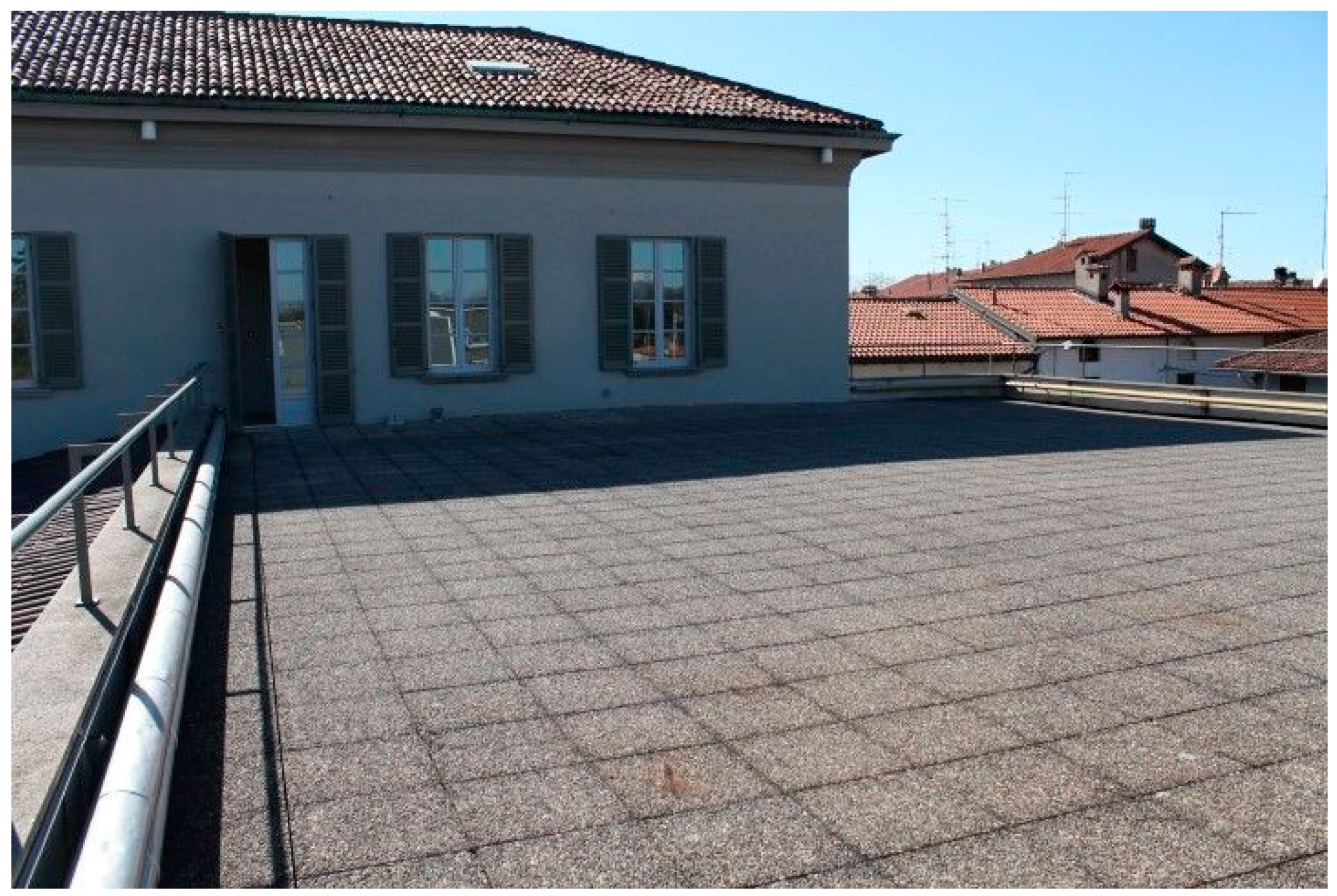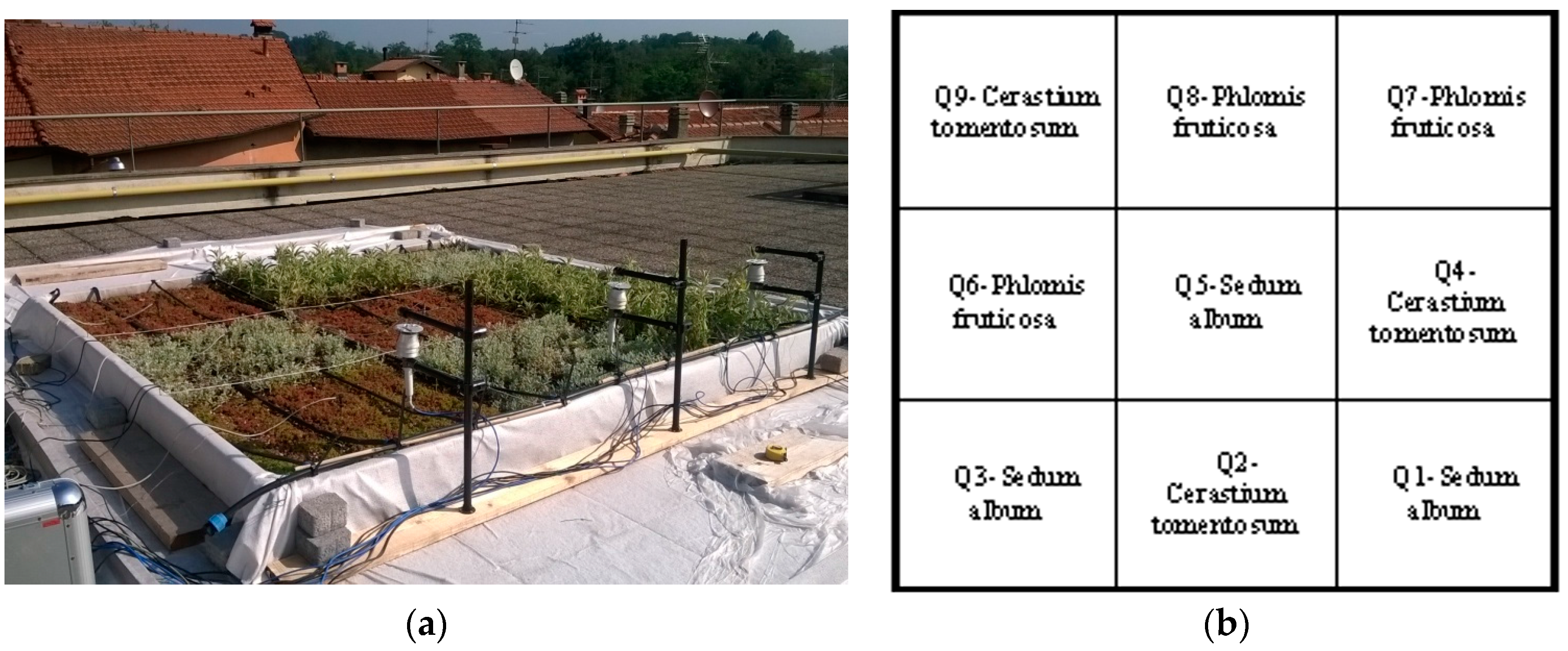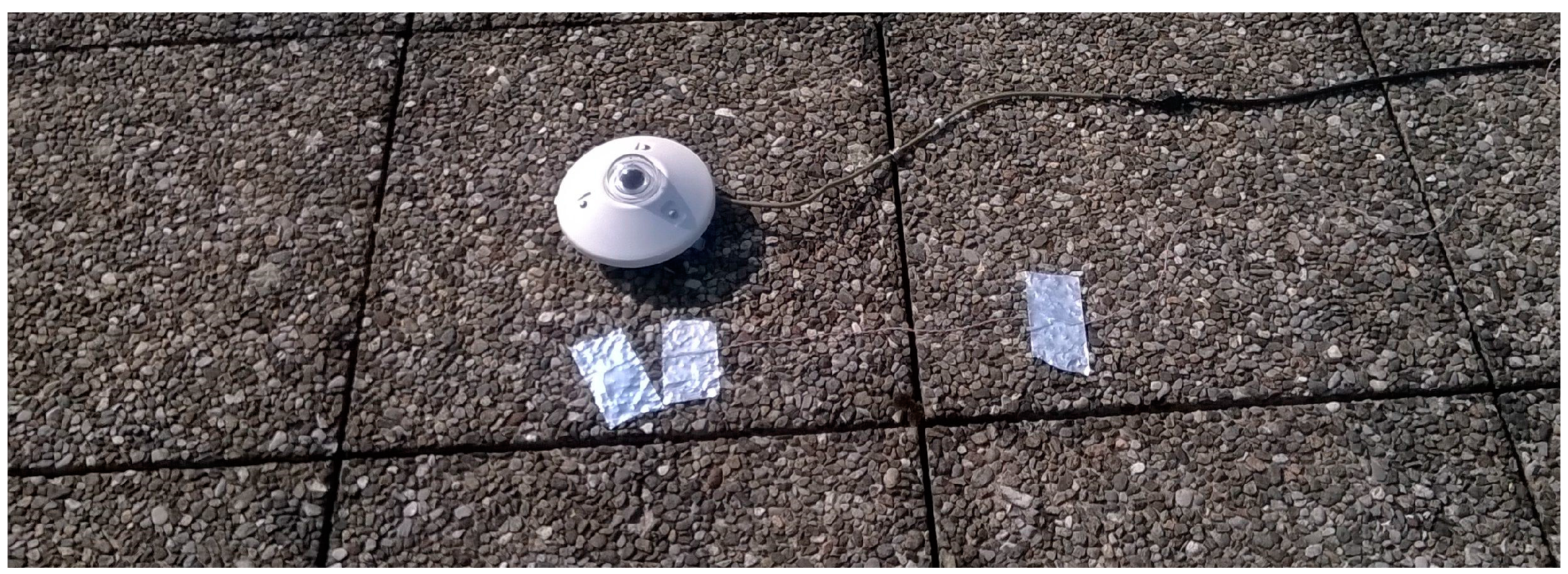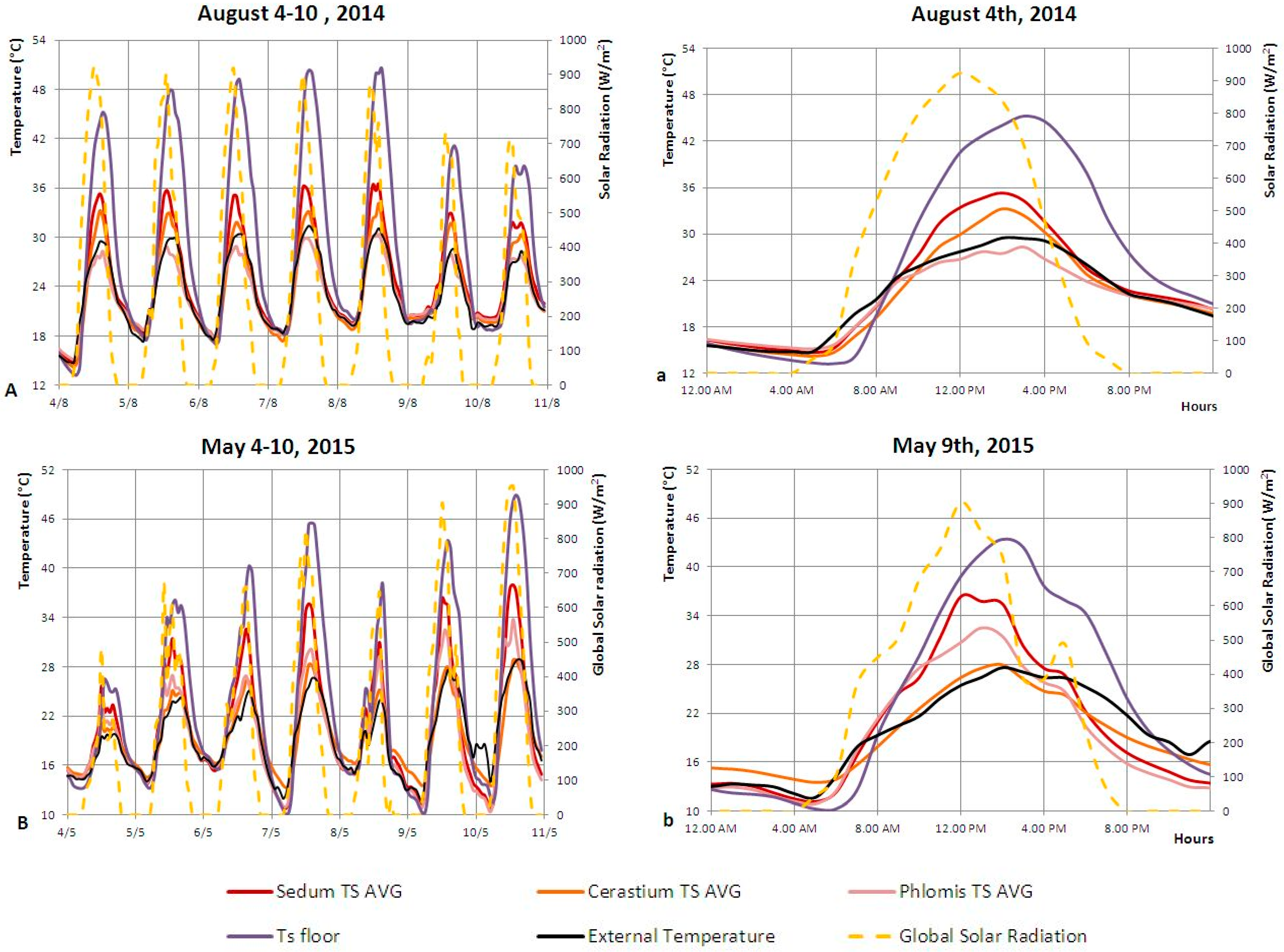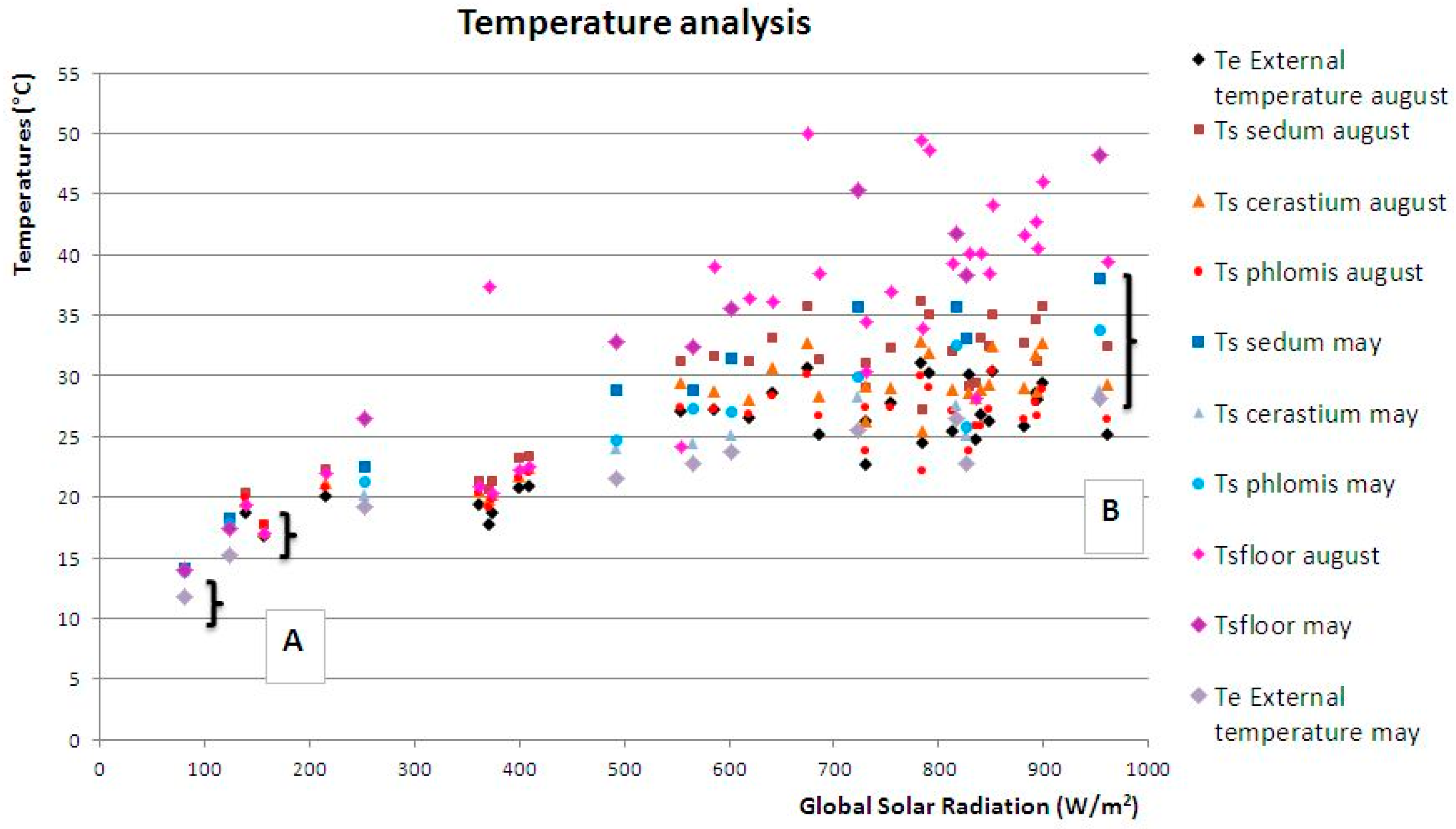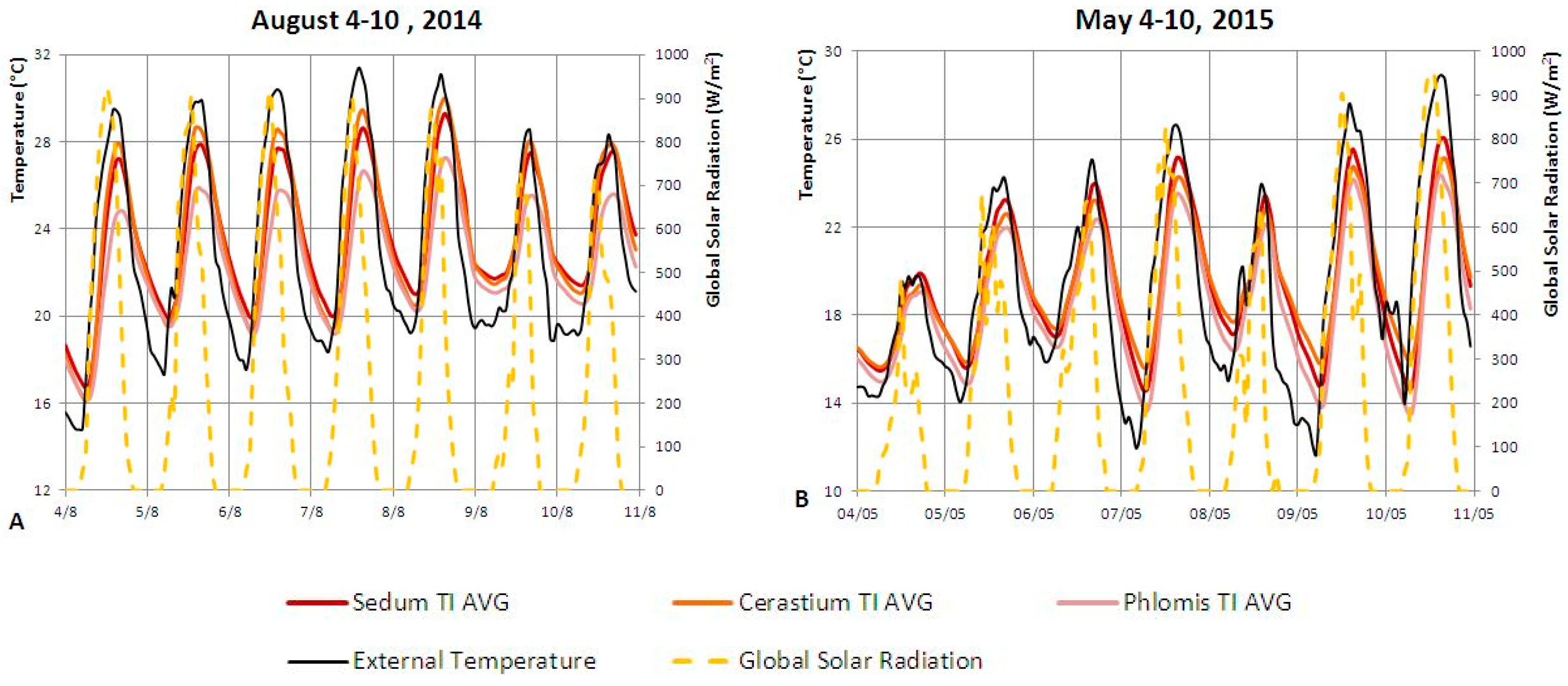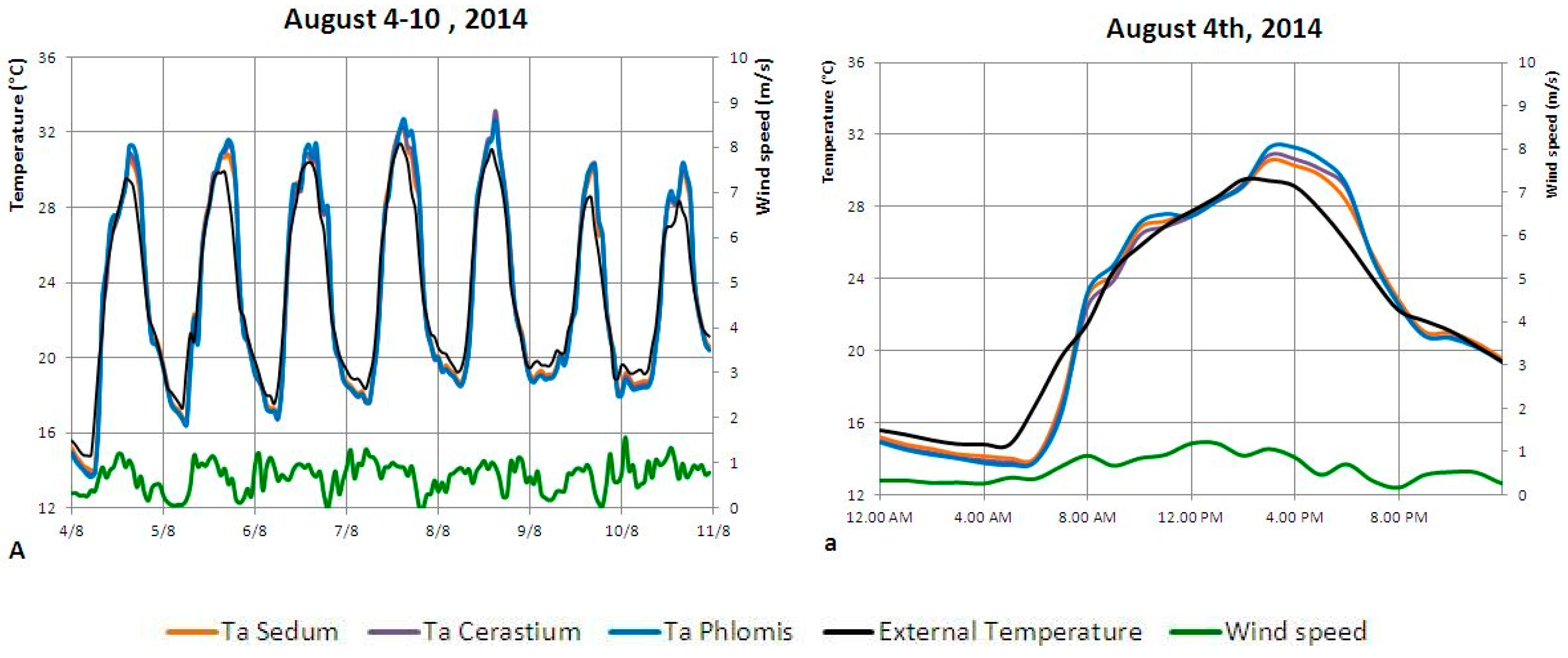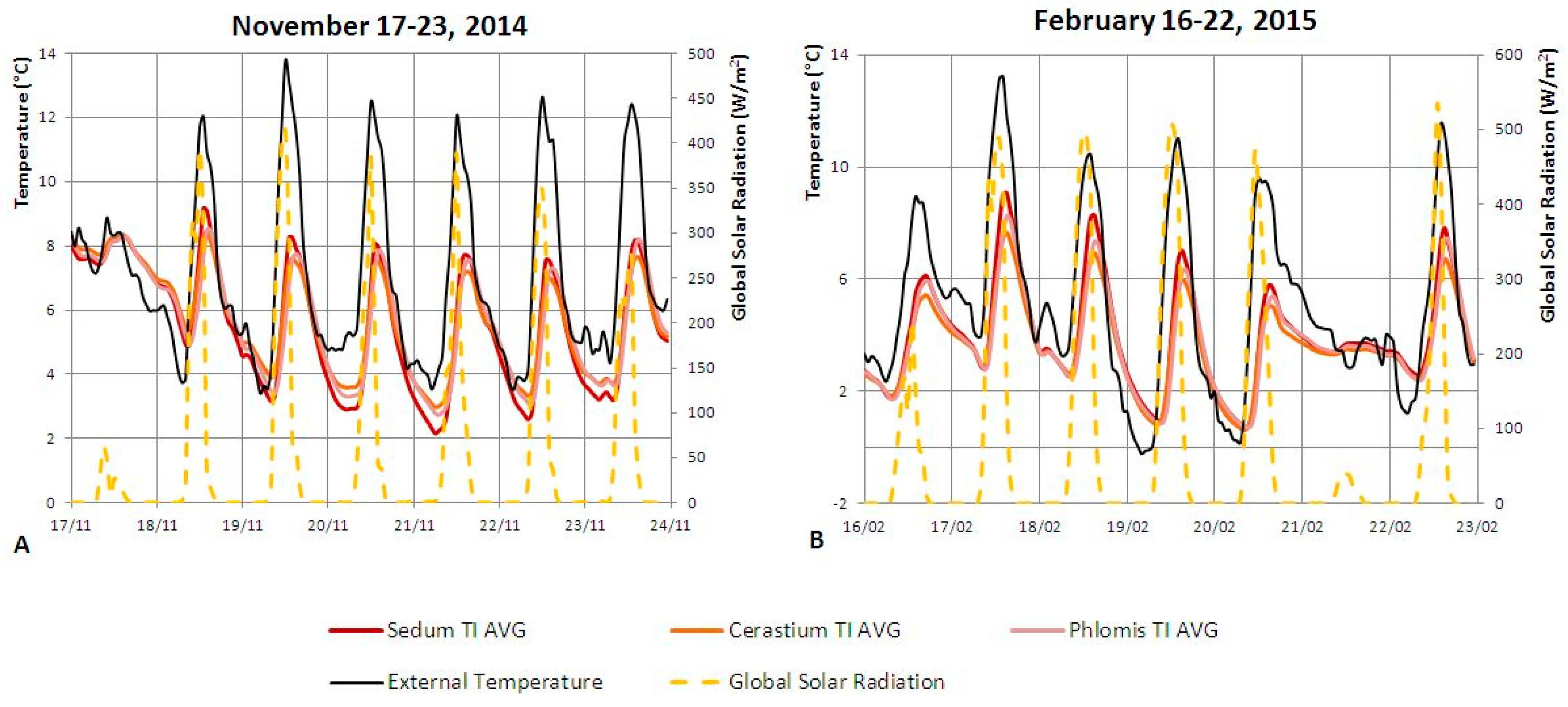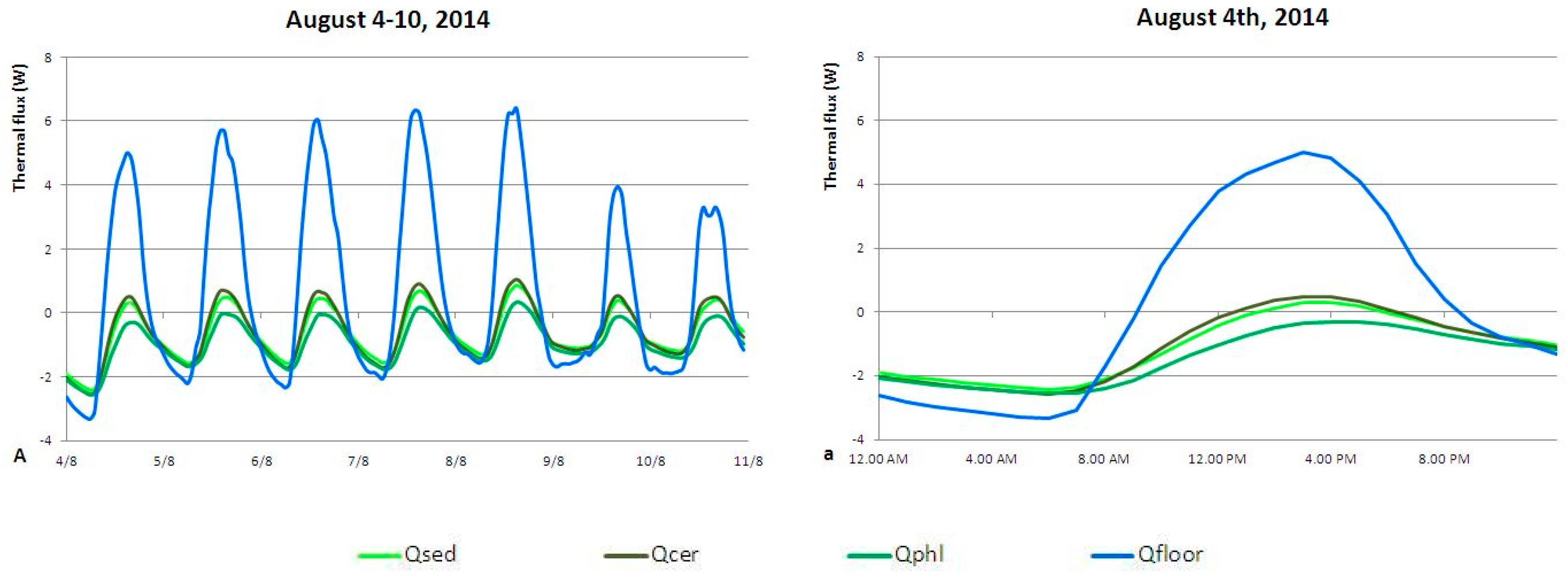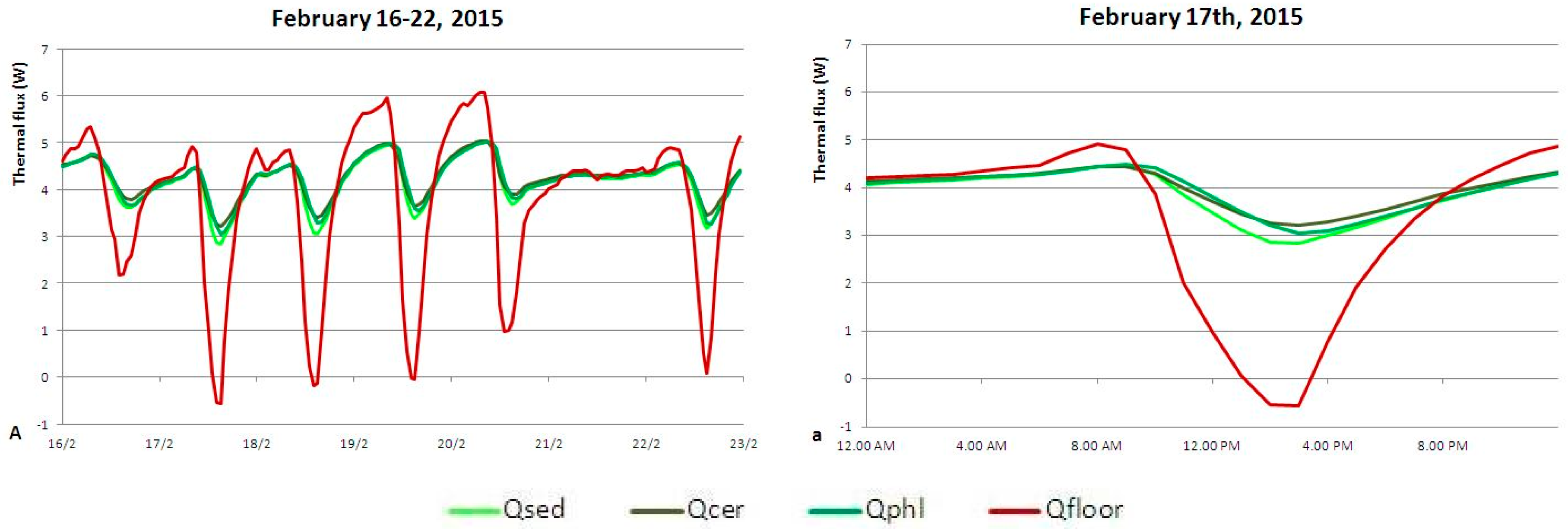For each of the tabled configurations, some reference weeks and days were chosen to show the main monitored results, divided into two periods of analysis as a function of similar main outdoor average characteristics: summer 2014/spring 2015; autumn 2014/winter 2014–2015.
The results presented and commented below correspond to the average data of the three plots per plant species.
3.1.1. Summer 2014 and Spring 2015
Figure 5 shows graphs concerning the surface temperature of the three plant species (T
s), as a function of the main outside parameters (external temperature and global solar radiation) with respect to two sample weeks, from 4–11 August 2014 (
Figure 5A,a), exemplifying summer of 2014, and from 4–11 May 2015 (
Figure 5B,b) for spring 2015.
The comparison of performances after one year is focused in order to highlight the incidence of leaf development and shading capacity of each plant species, under the same external conditions.
Graphs of
Figure 5 show how the surface temperature of the plant species (T
s), due to its high values, is a function of the solar radiation and it strongly depends on the shading ability of the three plant species. Due to its greater vertical development and greater leaf surface, right from the beginning of the experimental campaign
Phlomis offers better shading of the sensors, resulting in a surface temperature (T
s) which is significantly lower (
Figure 5a): on 4 May 2014,
Phlomis surface temperature T
s is 7.8 °C lower than
Sedum and 5.6 °C lower than
Cerastium. However, considering next spring (
Figure 5b),
Cerastium increases its performances: on 9 May 2015, its T
s is 10 °C lower than
Sedum and 4.3 °C than
Phlomis. The differences in T
s thermal gradients monitored over a year are mainly dependent on the plant leaf development of the three different plant species:
Cerastium thickens considerably, while
Phlomis tends to dry in the root stock.
Furthermore, by virtue of the different shading attitudes,
Cerastium shows a slight phase shift (about 2 h) with respect to the other two species in the attainment of the T
s peak value (
Figure 5b).
A correlation index, the Pearson product-moment correlation coefficient (Pearson’s r), was introduced to better understand, on the one hand, the relationship between the global solar radiation (I) and the plant species surface temperatures (Ts) and, on the other hand, the relationship between the external temperature (Te) and the surface temperatures of the plant species (Ts).
The correlation indexes, summarized in
Table 2, were calculated considering three different global solar radiation intervals daily (0–200, 400–600, and 800–1000 W/m
2, respectively) at solar peak. A sampling period of 41 days was considered (months of August 2014 and May 2015).
The analysis of the correlation index between the surface temperatures of the plant species (Ts) and the external temperature (Te) shows a direct correlation (Pearson’s r > 0) between them and, at the same time, underlines how the more the global solar radiation increases the more the correlation between (Ts) and (Te) decreases. Moreover, the correlation between the surface temperatures of the plant species (Ts) and the global solar radiation (I) is direct, increasing, and sensitive (0.8 < Pearson’s r < 1) between 100 W/m2 and 800 W/m2; on the contrary, considering very high values of global solar radiation (I > 800 W/m2) the correlation is less sensitive.
Instead,
Figure 6 shows the relationship, in terms of thermal gradients, between the surface temperatures of the plant species (T
s), external temperature (T
e) and global solar radiation (I), during solar peak time, (about 1:30 p.m.). The considered sampling period is 41 days (months of August 2014 and May 2015 -first ten days-).
The surface temperatures of the plant species (T
s) differ from the external temperature (T
e) with a thermal gradient on average lower than 5 °C (‘A’ data in
Figure 6) for low values of solar radiation (I < 500 W/m
2). Therefore, surface temperatures of the plant species (T
s) differ from the external temperature (T
e) with thermal gradients comprised between 15 °C and 20 °C (‘B’ data in
Figure 6) for high values of solar radiation (I > 500 W/m
2).
Therefore, the external temperature (Te) affects the seasonal peak value of the surface temperature of the plant species (Ts), while the global solar radiation determines the thermal gradient between Ts and Te.
Furthermore, all of the samples of
Figure 5 and
Figure 6 show how the performances improvement with respect to the paved surface (T
sfloor) of the terrace on which the experimentation is carried out, covered with grey finished grit tiles (
Figure 1), is quantified as shown in
Table 3.
As to the monitoring of the inside temperatures of the growing medium (T
i), measured at a depth of 8 cm,
Figure 7 shows trends as a function of both the global solar radiation (I) and the external temperature (T
e) related to 2014 (
Figure 7A) and 2015 (
Figure 7B), respectively.
The analysis of the inside temperature of the growing medium (T
i) leads to the following considerations: in general, T
i follows the solar radiation trend with an hourly phase displacement similar to the outdoor temperature variation and is affected by the solar shading potential of each plant species (as a function of leaf development and stem high). The trend of
Phlomis T
i is in accordance with the expectations, with values 2.5 °C lower than
Sedum, while the behavior of
Sedum and
Cerastium reverses with respect to the T
s trend; thus,
Cerastium T
i is 1 °C higher than
Sedum during the middle of the day. At the end of the experimental campaign, when the leaf development is maximum,
Sedum and
Cerastium T
i are almost the same, while
Phlomis T
i values are 1 °C lower than
Sedum.
Table 4 summarizes the comparisons between inside temperatures of the growing medium (T
i) and the surface temperatures of the terrace (T
sfloor), subject to direct solar radiation.
Figure 8 shows trends relating to the monitoring of air temperatures (T
a) at a height of 30 cm from the cultivation surface in three plots (Q1, Q4, and Q7, see
Figure 2a,b), with respect to a sample week (
Figure 8A) and a reference day (
Figure 8a). Trends shown in
Figure 8 are also confirmed for the whole monitoring period.
The evapotranspiration depends on solar radiation, water content in the growing medium, vegetation’s density and height [
35], and wind velocity and air humidity [
36]. Silva et al. [
35], demonstrate, through numerical analyses, that for each typology of green roof (extensive, intensive, and semi-intensive), evapotranspiration is more relevant in summer months (May–September), during which solar radiation is higher. When comparing extensive with intensive green roof solutions, evapotranspiration is higher for intensive green roofs that have a thicker substrate and higher plants [
35].
Figure 8A shows the outdoor air temperatures (T
a) at a height of 30 cm from the cultivation surface, whilst following the outdoor temperature (T
e) trend, its peaks amplify: T
a is, in fact, lower than T
e at night and higher in the daytime, with a phase shift of about two hours.
Cerastium is the species that shows the most sensitive difference between Ta and T
s both at night (−3.2 °C) and during daytime (+3.3 °C), followed by
Phlomis with a thermal gradient of −3.2 °C at night and 3.1 °C during daytime, and by
Sedum with −2.8 °C at night and +2.7 °C during daytime. The behavior at night is as expected in relation to UHI phenomenon characterized by higher temperatures at night due to the release of the heat accumulated during daytime [
37]. During daytime, instead, the positive effects depend on the evapotranspiration phenomenon are not sensitive due to both small-size crops and a low water content of the growing medium.
The wind speed parameter is considered not sensitive, because of the low values reached (<2 m/s).
3.1.2. Autumn 2014 and Winter 2014–2015
Figure 9 shows graphs related to the surface temperatures of the three plant species as a function of both the external temperature (T
e) and the global solar radiation (I) with respect to two reference weeks, from 17–24 November 2014 (
Figure 9A,a), representative of autumn 2014, and from 16–22 February 2015 (
Figure 9B,b), representative of winter 2014–2015.
The sample days shown in graphs
Figure 9a,b were chosen as a function of similar outdoor conditions in terms of outdoor temperature (14 °C of peak) and solar radiation level (500 W/m
2).
Even in the presence of small levels of global solar radiation, the surface temperature of the plant species (T
s) is a function of it, strongly depending on the shading attitude of the different plant species. In November (A,a), the growth of the initial planting allows to analyze temperatures trends during spring 2015 (
Figure 5B,b), even if to lesser degree of accuracy: on 19 November
Sedum and
Phlomis show surface temperatures that are, respectively, 4.1 °C and 2.2 °C higher than
Cerastium (at solar radiation peak). It is very interesting to observe how
Sedum, maybe due to its creeping development, shows the same behavior of the paved surface, with surface temperatures that are lower at night and higher during daytime (
Figure 9a). In February 2015, differences between the temperatures of the three species are more marked: surface temperature differences between
Sedum and
Phlomis, with respect to
Cerastium, are 8.2 °C and 3.5 °C higher, respectively (
Figure 9b).
The correlation index was calculated for wintertime too (
Table 5), considering three different global solar radiation intervals (0–200, 400–500, and 600–700 (during the sampling period (months of November 2014 and February 2015), the highest value reached by the global solar radiation was 647 W/m
2) W/m
2, respectively) at solar peak. A sampling period of 58 days was considered (months of November 2014 and February 2015).
First of all, the analysis of the correlation indexes between the surface temperatures of the plant species (Ts) and the external temperature (Te) shows a strong direct correlation (Pearson’s r > 0.7) for all the global solar radiation intervals. Secondly, the correlation between (Ts) and (I) is: direct and not sensitive (Pearson’s r < 0.3) between 100 W/m2 and 200 W/m2; negative and moderate around 500W/m2, and positive and strong (0.8 < Pearson’s r < 1) for I > 500W/m2.
Instead,
Figure 10 shows the relationship, in terms of thermal gradient, between the surface temperatures of the plant species (T
s), the external temperature (T
e) and the global solar radiation (I), during daily solar peak (about 12:30 p.m.). The considered sampling period is 58 days (months of November 2014 and February 2015).
The surface temperatures of the plant species (T
s) differ from the external temperature (T
e) with a thermal gradient on average lower than 5 °C (‘A’ data in
Figure 10) for low values of solar radiation (I < 500 W/m
2). Therefore, the surface temperatures of the plant species (T
s) differ from the external temperature (T
e) with thermal gradients of about 10 °C (‘B’ data in
Figure 10) for high values of solar radiation (I > 500 W/m
2). The trend is the same during summer and spring seasons, even with lower values in autumn and winter.
Therefore, the same conclusions reached on the basis of summer/spring data can be confirmed for autumn/winter data: the external temperature (Te) affects the seasonal peak value of the surface temperature of the plant species (Ts), while the global solar radiation determines the thermal gradient between Ts and Te.
Although the solar radiation peak reaches an energy value of about 500 W/m
2, significantly lower than it the spring/summer season, the thermal gradient between the planted plots T
s and the surface temperature of the paved cover (T
sfloor) of the terrace on which the experimental set-up is positioned, is marked.
Table 6 briefly summarizes thermal gradients between plots (T
s) and paved surface (T
sfloor).
With regard to the inside temperature (T
i) trends,
Figure 11 shows the related graphs.
Inside temperature trends reflect the outdoor ones: Sedum Ti is higher than the two other planted species, followed by Phlomis. Differences are, however, slight (about 0.5 °C) and inside temperatures tend to overlap, due to a very low thermal gradient.
Table 7 summarizes the comparison between inside temperatures of the plot (T
i) and paved surface temperatures (T
sfloor), under solar radiation.
